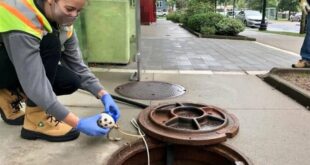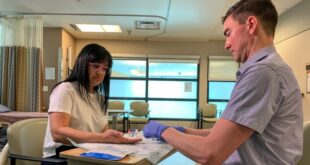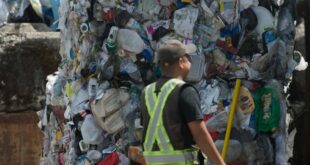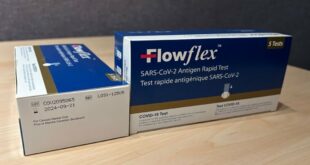Ehattesaht First Nation says young killer whale swam over sandbar on her own at high tide

The Ehattesaht First Nation says a killer whale calf that had been trapped in a remote Vancouver Island lagoon for more than a month is now free after it swam out on its own early Friday morning.
The nation said kʷiisaḥiʔis, or Brave Little Hunter, swam over the sandbar and out into open water during high tide around 2:30 a.m. PT.
After a long night of feeding kʷiisaḥiʔis and watching the calf play in the lagoon, the nation said, a small group "stood as witnesses to watch her swim under the bridge and down the inlet."
"Today the community of Zeballos and people everywhere are waking up to some incredible news and what can only be described as pride for the strength this little orca has shown," said Chief Simon John in a release.
The two-year-old female transient killer whale had been stuck in the tidal lagoon near the village of Zeballos, B.C., since March 23, when its pregnant mother became trapped at low tide and died on a rocky beach.
For weeks, First Nation members, DFO marine mammal experts, whale scientists and boat and machine operators gathered in the small community of about 200 people to plan how to free the calf.
Those discussions resulted in multiple rescue missions — all of them unsuccessful. Rescuers attempted to catch the orca and transport it by sling; they used recorded killer whale vocalizations to coax it out of the lagoon; around 10 boats attempted to herd the orca by using oikomi pipes to create a loud noise underwater; and a violinist even tried to serenade the calf to freedom.
But in the end, kʷiisaḥiʔis was her own saviour.
Connecting calf with family
After kʷiisaḥiʔis swam free, John says the calf was later seen in Espinosa Inlet and a team followed it as she moved toward Esperanza Inlet and the open ocean.
The team, which includes members of Fisheries and Oceans Canada's Marine Mammal Response and Bay Cetology, is hopeful that once the calf is in the ocean, its calls will be heard by its family.
John says officials and nation members are now putting protective measures in place to ensure there is no contact between kʷiisaḥiʔis and other people or boats.
They have asked the public to stay away from the area.
"With this part of the challenge solved by kʷiisaḥiʔis herself, every opportunity needs to be afforded to have her back with her family with as little human interaction as possible," he said.
Calf's mother couldn't be saved
While this chapter of kʷiisaḥiʔis' life has ended on a high note, it began with a tragedy.
Back in March, its 15-year-old mother became beached in the lagoon.
Video of the incident shows dozens of people trying to save the stranded orca, but it died.
A necropsy later confirmed the mother was pregnant with another calf.
As the weeks continued and the rescues failed, there were concerns over the wellbeing of kʷiisaḥiʔis and whether the calf was getting enough food and fresh water.
The orca was examined by experts and veterinarian staff from the Vancouver Aquarium who said in mid-April that it appeared to be in good health and was swimming well.
Last week, the calf also ate seal meat for what was believed to be the first time, after members of the neighbouring Nuchatlaht First Nation tossed about 18 kilograms of seal meat into the water.
ABOUT THE AUTHOR
Joel Ballard is a reporter with the CBC in Vancouver. You can reach him at joel.ballard@cbc.ca
*****
Credit belongs to : www.cbc.ca
 MaharlikaNews | Canada Leading Online Filipino Newspaper Portal The No. 1 most engaged information website for Filipino – Canadian in Canada. MaharlikaNews.com received almost a quarter a million visitors in 2020.
MaharlikaNews | Canada Leading Online Filipino Newspaper Portal The No. 1 most engaged information website for Filipino – Canadian in Canada. MaharlikaNews.com received almost a quarter a million visitors in 2020.







